- Home
- Jared Diamond
Collapse: How Societies Choose to Fail or Succeed Page 16
Collapse: How Societies Choose to Fail or Succeed Read online
Page 16
old volcanic islands than young volcanic islands;
islands without aerial ash fallout than islands with it;
islands far from Central Asia’s dust plume than islands near it;
islands without makatea than islands with it;
low islands than high islands;
remote islands than islands with near neighbors; and
small islands than big islands.
It turned out that all nine of the physical variables did contribute to the outcome (see the table above). Most important were variations in rainfall and latitude: dry islands, and cooler islands farther from the equator (at higher latitude), ended up more deforested than did wetter equatorial islands. That was as we had expected: the rate of plant growth and of seedling establishment increases with rainfall and with temperature. When one chops trees down in a wet hot place like the New Guinea lowlands, within a year new trees 20 feet tall have sprung up on the site, but tree growth is much slower in a cold dry desert. Hence regrowth can keep pace with moderate rates of cutting trees on wet hot islands, leaving the island in a steady state of being largely tree-covered.
Three other variables—island age, ash fallout, and dust fallout—had effects that we hadn’t anticipated, because we hadn’t been familiar with the scientific literature on the maintenance of soil fertility. Old islands that hadn’t experienced any volcanic activity for over a million years ended up more deforested than young, recently active volcanic islands. That’s because soil derived from fresh lava and ash contains nutrients that are necessary for plant growth, and that gradually become leached out by rain on older islands. One of the two main ways that those nutrients then become renewed on Pacific islands is by fallout of ash carried in the air from volcanic explosions. But the Pacific Ocean is divided by a line famous to geologists and known as the Andesite Line. In the Southwest Pacific on the Asian side of that line, volcanoes blow out ash that may be wind-carried for hundreds of miles and that maintains the fertility even of islands (like New Caledonia) that have no volcanoes of their own. In the central and eastern Pacific beyond the Andesite Line, the main aerial input of nutrients to renew soil fertility is instead in dust carried high in the atmosphere by winds from the steppes of Central Asia. Hence islands east of the Andesite Line, and far from Asia’s dust plume, ended up more deforested than islands within the Andesite Line or nearer to Asia.
Another variable required consideration only for half a dozen islands that consist of the rock known as makatea—basically, a coral reef thrust into the air by geological uplift. The name arises from the Tuamotu island of Makatea, which consists largely of that rock. Makatea terrain is absolute hell to walk over; the deeply fissured, razor-sharp coral cuts one’s boots, feet, and hands to shreds. When I first encountered makatea on Rennell Island in the Solomons, it took me 10 minutes to walk a hundred yards, and I was in constant terror of lacerating my hands on a coral boulder if I touched it while thoughtlessly extending my hands to maintain my balance. Makatea can slice up stout modern boots within a few days of walking. While Pacific Islanders somehow managed to get around on it in bare feet, even they had problems. No one who has endured the agony of walking on makatea will be surprised that Pacific islands with makatea ended up less deforested than those without it.
That leaves three variables with more complex effects: elevation, distance, and area. High islands tended to become less deforested (even in their lowlands) than low islands, because mountains generate clouds and rain, which descends to the lowlands as streams stimulating lowland plant growth by their water, by their transport of eroded nutrients, and by transport of atmospheric dust. The mountains themselves may remain forest-covered if they are too high or too steep for gardening. Remote islands became more deforested than islands near neighbors—possibly because islanders were more likely to stay home and do things impacting their own environment than to spend time and energy visiting other islands to trade, raid, or settle. Big islands tended to become less deforested than small islands, for numerous reasons including lower perimeter/area ratios, hence fewer marine resources per person and lower population densities, more centuries required to chop down the forest, and more areas unsuitable for gardening remaining.
How does Easter rate according to these nine variables predisposing to deforestation? It has the third highest latitude, among the lowest rainfalls, the lowest volcanic ash fallout, the lowest Asian dust fallout, no makatea, and the second greatest distance from neighboring islands. It is among the lower and smaller of the 81 islands that Barry Rolett and I studied. All eight of those variables make Easter susceptible to deforestation. Easter’s volcanoes are of moderate age (probably 200,000 to 600,000 years); Easter’s Poike Peninsula, its oldest volcano, was the first part of Easter to become deforested and exhibits the worst soil erosion today. Combining the effects of all those variables, Barry’s and my statistical model predicted that Easter, Nihoa, and Necker should be the worst deforested Pacific islands. That agrees with what actually happened: Nihoa and Necker ended up with no human left alive and with only one tree species standing (Nihoa’s palm), while Easter ended up with no tree species standing and with about 90% of its former population gone.
In short, the reason for Easter’s unusually severe degree of deforestation isn’t that those seemingly nice people really were unusually bad or improvident. Instead, they had the misfortune to be living in one of the most fragile environments, at the highest risk for deforestation, of any Pacific people. For Easter Island, more than for any other society discussed in this book, we can specify in detail the factors underlying environmental fragility.
Easter’s isolation makes it the clearest example of a society that destroyed itself by overexploiting its own resources. If we return to our five-point checklist of factors to be considered in connection with environmental collapses, two of those factors—attacks by neighboring enemy societies, and loss of support from neighboring friendly societies—played no role in Easter’s collapse, because there is no evidence that there were any enemies or friends in contact with Easter Island society after its founding. Even if it turns out that some canoes did arrive subsequently, such contacts could not have been on a large enough scale to constitute either dangerous attacks or important support. For a role of a third factor, climate change, we also have no evidence at present, though it may emerge in the future. That leaves us with just two main sets of factors behind Easter’s collapse: human environmental impacts, especially deforestation and destruction of bird populations; and the political, social, and religious factors behind the impacts, such as the impossibility of emigration as an escape valve because of Easter’s isolation, a focus on statue construction for reasons already discussed, and competition between clans and chiefs driving the erection of bigger statues requiring more wood, rope, and food.
The Easter Islanders’ isolation probably also explains why I have found that their collapse, more than the collapse of any other pre-industrial society, haunts my readers and students. The parallels between Easter Island and the whole modern world are chillingly obvious. Thanks to globalization, international trade, jet planes, and the Internet, all countries on Earth today share resources and affect each other, just as did Easter’s dozen clans. Polynesian Easter Island was as isolated in the Pacific Ocean as the Earth is today in space. When the Easter Islanders got into difficulties, there was nowhere to which they could flee, nor to which they could turn for help; nor shall we modern Earthlings have recourse elsewhere if our troubles increase. Those are the reasons why people see the collapse of Easter Island society as a metaphor, a worst-case scenario, for what may lie ahead of us in our own future.
Of course, the metaphor is imperfect. Our situation today differs in important respects from that of Easter Islanders in the 17th century. Some of those differences increase the danger for us: for instance, if mere thousands of Easter Islanders with just stone tools and their own muscle power sufficed to destroy their environment and thereby destroyed their societ
y, how can billions of people with metal tools and machine power now fail to do worse? But there are also differences in our favor, differences to which we shall return in the last chapter of this book.
CHAPTER 3
The Last People Alive: Pitcairn and Henderson Islands
Pitcairn before the Bounty ■ Three dissimilar islands ■ Trade ■ The movie’s ending ■
Many centuries ago, immigrants came to a fertile land blessed with apparently inexhaustible natural resources. While the land lacked a few raw materials useful for industry, those materials were readily obtained by overseas trade with poorer lands that happened to have deposits of them. For a time, all the lands prospered, and their populations multiplied.
But the population of the rich land eventually multiplied beyond the numbers that even its abundant resources could support. As its forests were felled and its soils eroded, its agricultural productivity was no longer sufficient to generate export surpluses, build ships, or even to nourish its own population. With that decline of trade, shortages of the imported raw materials developed. Civil war spread, as established political institutions were overthrown by a kaleidoscopically changing succession of local military leaders. The starving populace of the rich land survived by turning to cannibalism. Their former overseas trade partners met an even worse fate: deprived of the imports on which they had depended, they in turn ravaged their own environments until no one was left alive.
Does this grim scenario represent the future of the United States and our trade partners? We don’t know yet, but the scenario has already played itself out on three tropical Pacific islands. One of them, Pitcairn Island, is famous as the “uninhabited” island to which the mutineers from the H.M.S. Bounty fled in 1790. They chose Pitcairn because it was indeed uninhabited at that time, remote, and hence offered a hiding place from the vengeful British navy searching for them. But the mutineers did find temple platforms, petroglyphs, and stone tools giving mute evidence that Pitcairn had formerly supported an ancient Polynesian population. East of Pitcairn, an even more remote island named Henderson remains uninhabited to this day. Even now, Pitcairn and Henderson are among the most inaccessible islands in the world, without any air or scheduled sea traffic, and visited only by the occasional yacht or cruise ship. Yet Henderson, too, bears abundant marks of a former Polynesian population. What happened to those original Pitcairn Islanders, and to their vanished cousins on Henderson?
The romance and mystery of the H.M.S. Bounty mutineers on Pitcairn, retold in many books and films, are matched by the mysterious earlier ends of these two populations. Basic information about them has at last emerged from recent excavations by Marshall Weisler, an archaeologist at the University of Otago in New Zealand, who spent eight months on those lonely outposts. The fates of the first Pitcairners and the Henderson Islanders prove to have been linked to a slowly unfolding environmental catastrophe hundreds of miles overseas on their more populous island trading partner, Mangareva, whose population survived at the cost of a drastically lowered standard of living. Thus, just as Easter Island offered us our clearest example of a collapse due to human environmental impacts with a minimum of other complicating factors, Pitcairn and Henderson Islands furnish our clearest examples of collapses triggered by the breakdown of an environmentally damaged trade partner: a preview of risks already developing today in association with modern globalization. Environmental damage on Pitcairn and Henderson themselves also contributed to the collapses there, but there is no evidence for roles of climate change or of enemies.
Mangareva, Pitcairn, and Henderson are the sole habitable islands in the area known as Southeast Polynesia, which otherwise includes just a few low atolls supporting only temporary populations or visitors but no permanent populations. These three habitable islands were settled sometime around A.D. 800, as part of the eastwards Polynesian expansion explained in the preceding chapter. Even Mangareva, the westernmost of the three islands and hence the one closest to previously settled parts of Polynesia, lies about a thousand miles beyond the nearest large high islands, such as the Societies (including Tahiti) to the west and the Marquesas to the northwest. The Societies and Marquesas in turn, which are the largest and most populous islands in East Polynesia, lie more than a thousand miles east of the nearest high islands of West Polynesia and may not have been colonized until perhaps nearly 2,000 years after West Polynesia’s settlement. Thus, Mangareva and its neighbors were isolated outliers even within Polynesia’s more remote eastern half. They were probably occupied from the Marquesas or Societies during the same colonizing push that reached the even more remote Hawaiian Islands and Easter, and that completed the settlement of Polynesia (maps, pp. 84-85 and this page).
Of those three habitable islands of Southeast Polynesia, the one capable of supporting by far the largest human population, and most abundantly endowed with natural resources important to humans, was Mangareva. It consists of a large lagoon 15 miles in diameter, sheltered by an outer reef, and containing two dozen extinct volcanic islands and a few coral atolls with a total land area of 10 square miles. The lagoon, its reefs, and the ocean outside the lagoon teem with fish and shellfish. Especially valuable among the species of shellfish is the black-lipped pearl oyster, a very large oyster of which the lagoon offered virtually inexhaustible quantities to Polynesian settlers, and which is the species used today to raise the famous black cultured pearls. In addition to the oyster itself being edible, its thick shell, up to eight inches long, was an ideal raw material that Polynesians carved into fishhooks, vegetable peelers and graters, and ornaments.
The higher islands of Mangareva’s lagoon received enough rain to have springs and intermittent streams, and were originally forested. In the narrow band of flat land around the coasts, the Polynesian colonists built their settlements. On the slopes behind the villages they grew crops such as sweet potato and yams; terraced slopes and flats below the springs were planted in taro, irrigated by spring water; and higher elevations were planted in tree crops such as breadfruit and bananas. In this way, farming and fishing and gathering of shellfish would have been able to support a human population of several thousand on Mangareva, more than 10 times the likely combined populations of Pitcairn and Henderson in ancient Polynesian times.
From a Polynesian perspective, Mangareva’s most significant drawback was its lack of high-quality stone for making adzes and other stone tools. (That’s as if the United States contained all important natural resources except high-grade iron deposits.) The coral atolls in Mangareva lagoon had no good raw stone at all, and even the volcanic islands offered only relatively coarse-grained basalt. That was adequate for building houses and garden walls, using as oven stones, and fashioning into canoe anchors and food pounders and other crude tools, but coarse-grained basalt yielded only inferior adzes.
Fortunately, that deficiency was spectacularly remedied on Pitcairn, the much smaller (2½ square miles) and steeper extinct volcanic island lying 300 miles southeast of Mangareva. Imagine the excitement when the first canoeload of Mangarevans discovered Pitcairn after several days’ travel on open ocean, landed at its only feasible beach, scrambled up the steep slopes, and came upon Down Rope Quarry, Southeast Polynesia’s sole useable lode of volcanic glass, whose flakes could serve as sharp tools for fine cutting tasks—the Polynesian equivalent of scissors and scalpels. Their excitement would have turned to ecstasy when, barely a mile farther west along the cost, they discovered the Tautama lode of fine-grained basalt, which became Southeast Polynesia’s biggest quarry for making adzes.
In other respects, Pitcairn offered much more limited opportunities than did Mangareva. It did have intermittent streams, and its forests included trees large enough to fashion into hulls of outrigger canoes. But Pitcairn’s steepness and small total area meant that the area of level plateau suitable for agriculture was very small. An equally serious drawback is that Pitcairn’s coastline lacks a reef, and the surrounding sea bottom falls off steeply, with the result that fishing a
nd the search for shellfish are much less rewarding than on Mangareva. In particular, Pitcairn has no beds of those black-lipped pearl oysters so useful for eating and tool-making. Hence the total population of Pitcairn in Polynesian times was probably not much greater than a hundred people. The descendants of the Bounty mutineers and their Polynesian companions living on Pitcairn today number only 52. When their number climbed from the original band of 27 settlers in 1790 to 194 descendants in the year 1856, that population overtaxed Pitcairn’s agricultural potential, and much of the population had to be evacuated by the British government to distant Norfolk Island.
The remaining habitable island of Southeast Polynesia, Henderson, is the largest (14 square miles) but is also the most remote (100 miles northeast of Pitcairn, 400 miles east of Mangareva) and the most marginal for human existence. Unlike Mangareva or Pitcairn, Henderson is not volcanic but is in effect a coral reef that geological processes thrust up 100 feet above sea level. Hence Henderson is devoid of basalt or other rocks suitable for tool-making. That’s a severe limitation for a society of stone tool makers. An additional severe limitation for any humans is that Henderson has no streams or reliable freshwater sources, because the island consists of porous limestone. At best, for a few days after the unpredictable arrivals of rain, water drips from the roofs of caves, and puddles of water can be found on the ground. There is also a freshwater spring that bubbles up in the ocean about 20 feet offshore. During Marshall Weisler’s months on Henderson, he found obtaining drinking water even with modern tarpaulins to catch the rain a constant effort, and most of his cooking and all of his washing and bathing had to be carried out with saltwater.
Even soil on Henderson is confined to small pockets between the limestone. The island’s tallest trees are only about 50 feet high and not big enough to fashion into canoe hulls. The resulting stunted forest and thick undergrowth are so dense that they require a machete to penetrate them. Henderson’s beaches are narrow and confined to the north end; its south coast consists of vertical cliffs where it is impossible to land a boat; and the south end of the island is a makatea landscape thrown into alternating rows of razor-sharp limestone ridges and fissures. That south end has been reached only three times by groups of Europeans, one of them Weisler’s group. It took Weisler, wearing hiking boots, five hours to cover the five miles from Henderson’s north coast to its south coast—where he promptly discovered a rock shelter formerly occupied by barefoot Polynesians.

 Why Is Sex Fun?: The Evolution of Human Sexuality
Why Is Sex Fun?: The Evolution of Human Sexuality Guns, Germs, and Steel: The Fates of Human Societies
Guns, Germs, and Steel: The Fates of Human Societies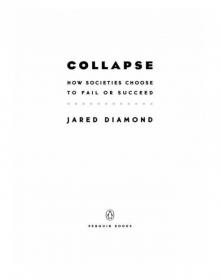 Collapse: How Societies Choose to Fail or Succeed
Collapse: How Societies Choose to Fail or Succeed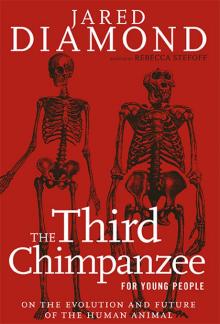 The Third Chimpanzee: The Evolution and Future of the Human Animal
The Third Chimpanzee: The Evolution and Future of the Human Animal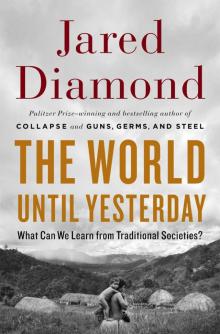 The World Until Yesterday: What Can We Learn From Traditional Societies?
The World Until Yesterday: What Can We Learn From Traditional Societies?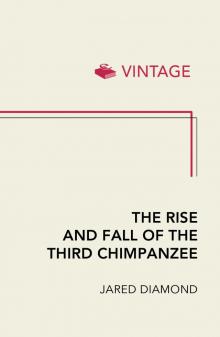 The Rise and Fall of the Third Chimpanzee
The Rise and Fall of the Third Chimpanzee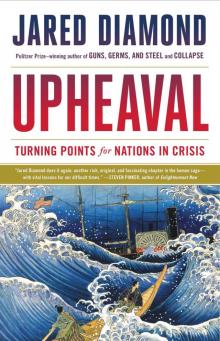 Upheaval: Turning Points for Nations in Crisis
Upheaval: Turning Points for Nations in Crisis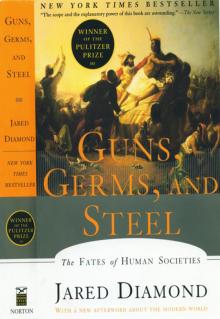 Guns, Germs, and Steel
Guns, Germs, and Steel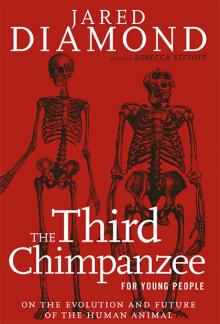 The Third Chimpanzee for Young People
The Third Chimpanzee for Young People Why Is Sex Fun?
Why Is Sex Fun?